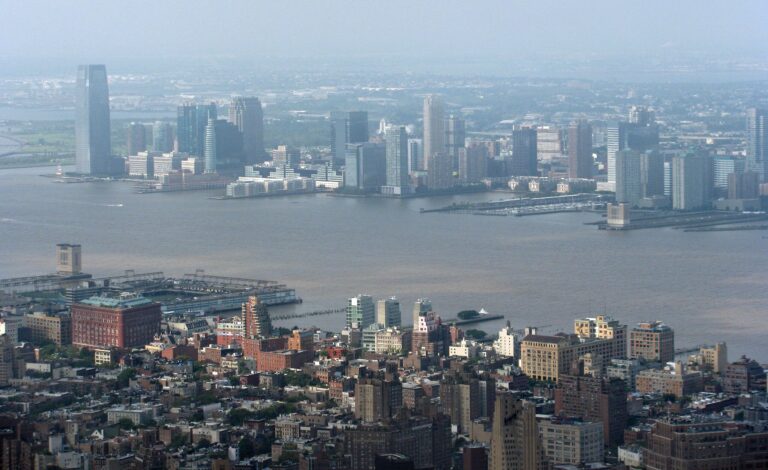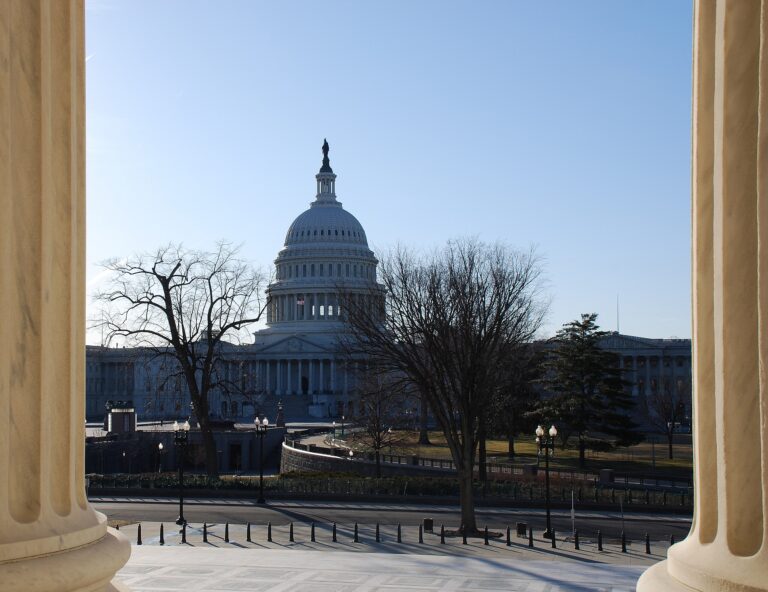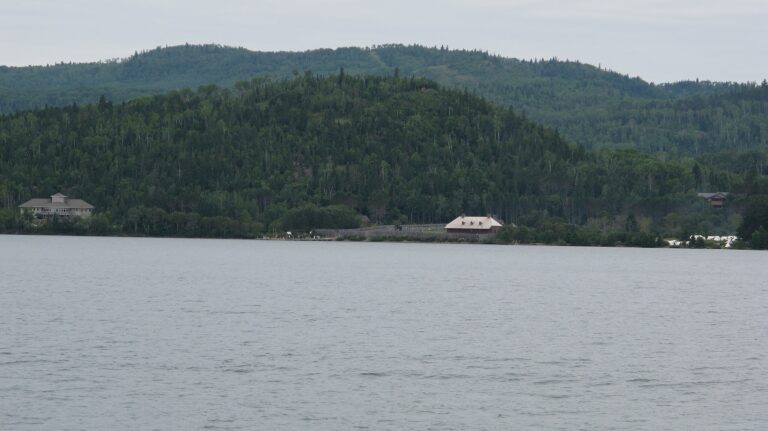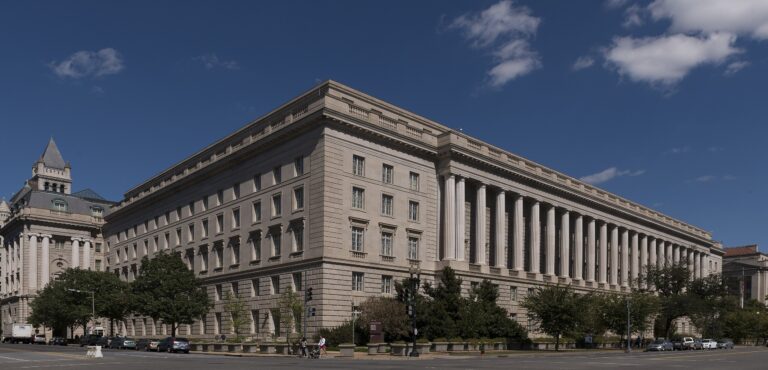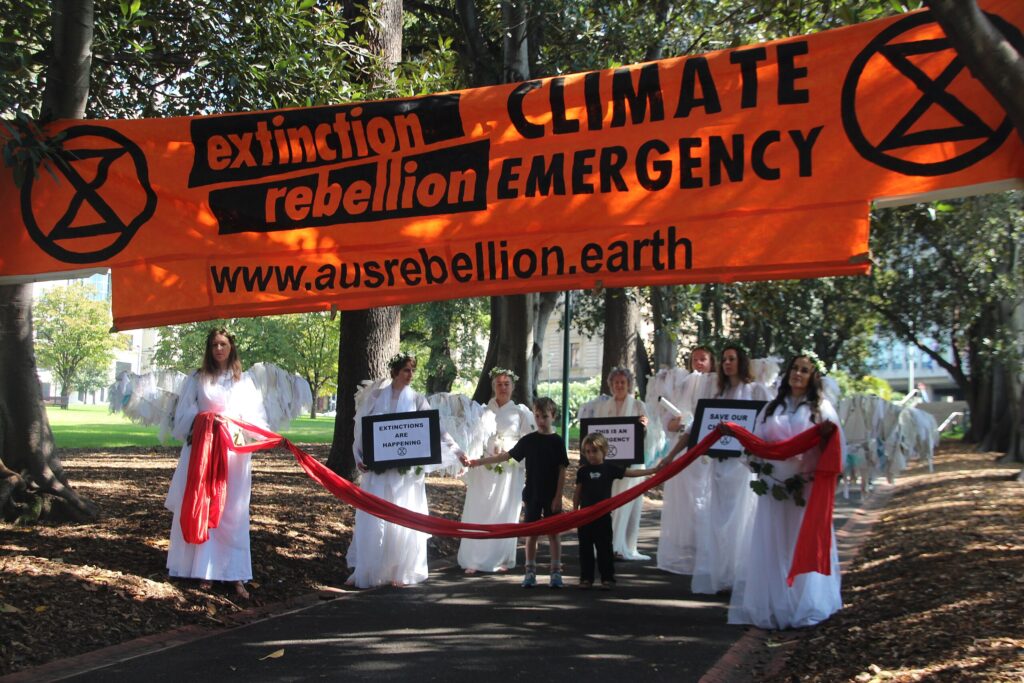
Greener Doesn’t Equal Fairer: Centering Justice and Inclusion in Sustainability Transitions
E.K. Wilson
“Climate Angels at Extinction Rebellion Declaration Day Melbourne” by John Englart (CC BY-SA 2.0)
“I don’t want the same world, just eco.” These are the words of an activist interviewed in the 2021 documentary, Rebellion, directed by Maia Kenworthy and Elena Sánchez Bellot. The film tells the story of Extinction Rebellion (XR), arguably one of the most disruptive civil disobedience movements ever seen; of its successes, its failures, its strengths, its weaknesses. On the one hand, the movement succeeded in giving focus, direction, and a feeling of control to people who had felt overwhelmed, anxious, powerless, and hopeless in the face of the climate emergency. On the other, the documentary reveals that XR risked replicating and reinforcing existing structures of power and inequality. Tensions rise as one of the founders and key leaders of the movement, controversial figure Roger Hallam, exhibits elements of authoritarian-style leadership through unilateral decision-making. Other members of the leadership group, including his own daughter, feel increasingly excluded. His failure to include other leaders in these processes and prioritise fairness, democracy, justice and inclusion ultimately leads to his ejection from the movement.
For many climate activists, such internal hierarchical and authoritarian power structures are fundamentally at odds with their ultimate goals. For them, climate change is not just a scientific or an economic problem. It is a political problem. It is, at its core, an issue of injustice. A movement that aggressively campaigns for action on climate change, yet does so at the expense of equality, inclusion, democracy, and fairness in its own processes, is not modelling the kind of world activists want to see. In other words, XR faced similar challenges to other social justice movements, institutions, organisations and campaigns: Is justice secondary to the goal of climate action, or is it an inextricable, essential part of the process?
There is growing scholarly, policy, and societal consensus that justice, inclusion, and equality must be at the core of how we respond to the climate emergency. As the Dutch politician Frans Timmermans stated in an oft-quoted speech to the European Economic and Social Committee in 2020: “This transition will be just, or there will be no transition.” But what justice, inclusion, and equality are, what they look like, how they are to be enacted, differ from place to place. Ensuring justice in climate transitions is not just about ensuring an equality of outcomes – that everyone has access to clean energy, for example, or that everyone’s risk exposure to extreme weather events is as minimal as possible. Just climate transitions must also be about whose voices are heard, whose expertise and experiences are taken seriously, and whose understandings of the world are prioritised.
It is here that religion becomes a critical factor to consider. Religious and spiritual traditions contribute to conceptualisations of justice and inclusivity across the world. At the same time, there is an identifiable “secular bias” against non-secular (i.e. religious, spiritual, indigenous) ontologies that, in the context of climate adaptation, has actively contributed to devaluing the experiences, perspectives, and contribution of organizations and communities whose worlds are constituted with gods, spirits, the transcendent and ephemeral.
The discourse of climate change is dominated by science and all the connotations that term carries with it, including the need for measurable, quantifiable data, rationality, objectivity, and neutrality. A brief consideration of definitions of climate change demonstrates this point. The United Nations Framework Convention on Climate Change (UNFCCC) defines climate change as “a change of climate which is attributed directly or indirectly to human activity that alters the composition of the global atmosphere and which is in addition to natural climate variability observed over comparable time periods. National Aeronautics and Space Administration (NASA) offers the following definition:
Climate change is a long-term change in the average weather patterns that have come to define Earth’s local, regional and global climates. These changes have a broad range of observed effects that are synonymous with the term.
Changes observed in Earth’s climate since the mid-20th century are driven by human activities, particularly fossil fuel burning, which increases heat-trapping greenhouse gas levels in Earth’s atmosphere, raising Earth’s average surface temperature.
Other national and international bodies adopt similar language and definitions.
Yet these descriptions that focus on the scientific diagnoses of climate change are highly sanitized. They emphasise the physical processes involved in a changing climate, scrubbing away the living beings who have contributed to it and who have been impacted and harmed by these processes, and will continue to be so. As climate scientist and Professor of Human Geography at Cambridge University Mike Hulme notes, climate change is both a physical and a social phenomenon. As the issue of climate change has spread beyond the boundaries of the purely scientific to encounter culture, economics, politics and religion, ideas about what climate change is and what it represents, have become deeply entangled with issues of class, race, nationality, ethnicity, identity, politics, and spirituality.
Yet climate change is not and never has been solely about science. It is about power. As religious studies scholars Evan Berry and Terra Schwerin Rowe write, climate change involves “the sources and forms of power, the byproducts of energy technologies, and technological change over time.” These technological innovations have rendered multiple disruptions in social, political, economic, cultural and religious fabric over time, often generating new insecurities and inequalities, even as they bring increased standards of living and improved livelihoods. For example, despite bringing rapid technological advancements and increases in wealth and living standards, the industrial revolution was built on the exploitation of the poor, through long hours and hazardous working conditions. Similarly, the consequences of climate change are also unevenly distributed. People who are poor and disenfranchised are affected far more seriously by climate change than the wealthy and powerful. And the identities of those who are poor, marginalized and excluded map onto existing structures of racial, sexual, gender, ethnic, economic, and religious inequalities. As climate scientist Friedrike Otto highlights in her recent book, economic and socio-political inequalities are not separate from the challenge of climate change. They are the challenge of climate change.
In part because of the recognition of these inherent inequalities entangled with climate change, there is at times an implicit assumption that any efforts to address climate change through mitigation and adaptation, transitions to clean energy and so on are inherently just. Climate change itself is the great injustice. By transitioning to cleaner energy and taking proactive measures to address climate change, we therefore also address societal injustice. Yet this narrative also operates as code for maintaining the same social and political structures of marginalization and exclusion, just powered by different energy sources. Climate adaptation and mitigation measures address injustice only in the sense that they lessen the worst of the impacts of climate change on those who are already vulnerable. It may somewhat lessen the marginalization and vulnerability they experience in the context of a changing climate, but it does little to improve their situation relative to other sources of inequality in society.
Thus, if we are to really address climate change and not just tinker around the edges, we must fundamentally rethink how we make decisions, who is sitting at the table when we make decisions, and what the main issues or factors are that we take into consideration when decisions are made. And as a result of the privileging of secular, scientific perspectives on and experiences of climate change, the exclusion of individuals and communities based on their religious and spiritual worldviews is still a major problem in consultative and inclusive research, governance and decision-making.
In my work as a scholar, teacher, trainer, and policy advisor, I encounter two main kinds of assumptions about religion and climate change. The first of these is that religion has very little, if anything, to do with climate change. Climate change is a process primarily related to the rational realm of science and the natural world. Religion is concerned with the irrational dimension of faith and is predominantly focused on the supernatural world. Consequently, the assumption goes, religion is not relevant for discussions on climate change.
The second assumption is the opposite of the first. Rather than seeing religion as unrelated to climate change, this view holds that religion, primarily Christianity, bears varying degrees of responsibility for the environmental crisis. The historian Lynn White, Jr. articulated this view most succinctly in his 1967 article “The Historical Roots of Our Ecological Crisis”. In this article, White claimed that “Especially in its Western form, Christianity is the most anthropocentric religion the world has ever seen.” Not only did Christianity establish a “dualism of man and nature but also insisted that it is God’s will that man exploit nature for his proper ends.”
Both positions are reflective of broader assumptions that colour how we think about religion in general. What they share is the idea that we can clearly see and label what religion is, and that religion as an object can be normatively judged as good or bad. Yet what religion is shifts from place to place. Which religious traditions are we speaking of, for example? Even if we consider White’s argument, where he focuses solely on Western Christianity – there are still vast numbers of denominations within Western Christianity who would vehemently disagree with the idea that it is God’s will that humans should exploit nature. Catholic Social Teaching advocates stewardship, for example, while eco-feminist theologies do away with the dualism of humanity and nature altogether. The fate of humanity and of the natural world are one and the same.
The point here is not to get into a theological exegesis, but rather to highlight these dominant assumptions that limit the way we think about religion and its relationship with climate change. Challenging these assumptions matters, because as long as we continue to exclude religion, understood in various ways, from conversations around climate justice, we also limit the resources we have for reconfiguring and reimagining our social and political structures in order to move to a different kind of world. More than that, we also commit a kind of ontological injustice, devaluing particular ways of being in and knowing the world. If we truly engage with the ways other cultures and peoples make sense of the space and places they inhabit, we come to see that we don’t all simply exist in the same world and have different perspectives on it. We actually live in different worlds. Some of us inhabit a world where science is the ultimate source of knowledge, and the most trustworthy source of information for determining policy and action. Yet others of us live in a world where our ancestors inhabit the trees, rocks, rivers, streams and mountains on which we exist. We live in a world where spirits form our life force, or where God sits at the centre of everything.
For some, this will provoke an immediate negative reaction. A normative and judgmental reaction. Spirits do not exist. God is not real. We cannot base decision-making on things that we cannot see or prove. But it is precisely these kinds of reactions we need to call into question. This does not entail that everyone must believe that God is real or that spirits inhabit the world. What it does involve is accepting and respecting that for some people, cultures, communities, these things are very real. It is their world. And trying to talk about climate change, or how to adapt and respond to climate change without taking those worlds seriously, and treating them with respect and value, including them in decision-making and discourses of climate justice, is self-defeating.
Patrick Nunn, a professor of geography at the University of the Sunshine Coast in Queensland, Australia, with decades of experience working on climate-related challenges in the Pacific, has been arguing for years that climate adaptation projects that do not take religion into consideration are doomed to fail. He notes a succession of climate adaptation and mitigation projects that have been undertaken and funded by secular government and non-government agencies, all of which have ultimately been unsuccessful. The common denominator, he says, is their failure to take the religious worldviews that dominate the Pacific region seriously. The Pacific region is 95% Christian. People understand the world through their relationships with God, church, spirituality, and morality. For many, this makes more sense and gives them more control over their own futures than a purely secular worldview.
Sociologist Amanda Bertana observes that in coastal areas in the Pacific, such as her fieldwork site of Narikoso, Fiji, people have been adapting to changes in weather patterns, sea levels, extreme weather events, for years. They have migrated between mountains and coast over centuries, in harmony with the rhythms of the world around them. As her interlocutors told her, secular science for them brings fear. The secular science narrative situates people in the Pacific as purely victims of climate change, with little to no agency. They did not cause climate change, but there is nothing they can do about it, except to move to higher ground, or relocate to other islands or countries. This outlook engenders anxiety and powerlessness. In contrast, their Christian worldview tells them that God has a plan for them, that He has promised never to flood the earth again, that He will protect and look after them. This is not to say that there are not problems and fallibilities with religious outlooks that need to be taken seriously. One concerning development is people within communities being blamed for the vulnerabilities engendered by climate change, due to their supposed “sins” or moral failings. Religious and spiritual worldviews carry their own inequalities and injustices to which we also need to be sensitive. But the implicit assumption that somehow “secular” scientific worldviews are superior to religious ones or offer a better way of approaching the challenges of climate change is a bias that we need to rethink. While secular perspectives may be the most effective means for promoting action in some contexts, they will have little or even detrimental impacts in others.
But perhaps there is a way to bring the two ontologies together. Traditional Owners of Country and climate scientists in Australia, for example, are working together to integrate scientific and indigenous insights to address climate impacts. Climate scientist and communicator Katharine Hayhoe has long advocated that starting with science does not convince people about the reality and urgency of the climate crisis. Starting with their values does. Working in the United States, where attitudes towards climate change are inextricably entangled with political and religious identities, this is something she must constantly navigate.
Yet engaging with religious communities, institutions, identities and worldviews is not merely a question of how to effectively advocate for action on climate change and nor is it a question that is confined to areas noted for their religiosity, such as the Pacific region, or the United States. A recent Pew Research Center report suggests that 75% of the global population identifies as religious. And it’s important to remember that worldviews and ontologies are not static. Even in areas once considered bastions of secularisation, interest in religion is on the rise.
In this context, not taking religious and spiritual worldviews into consideration is almost a tyranny of a minority over a majority. More than a question of effective advocacy for climate action, taking religious and spiritual ontologies seriously and including them in decision-making is a question of justice.

Erin K. Wilson is Professor and Chair of Politics and Religion in the Faculty of Religion, Culture and Society at the University of Groningen.
Recommended Citation
Wilson, Erin K. “Greener Doesn’t Equal Fairer: Centering Justice and Inclusion in Sustainability Transitions.” Canopy Forum, July 31, 2025. https://canopyforum.org/2025/07/31/greener-doesnt-equal-fairer-centering-justice-and-inclusion-in-sustainability-transitions/
Recent Posts


